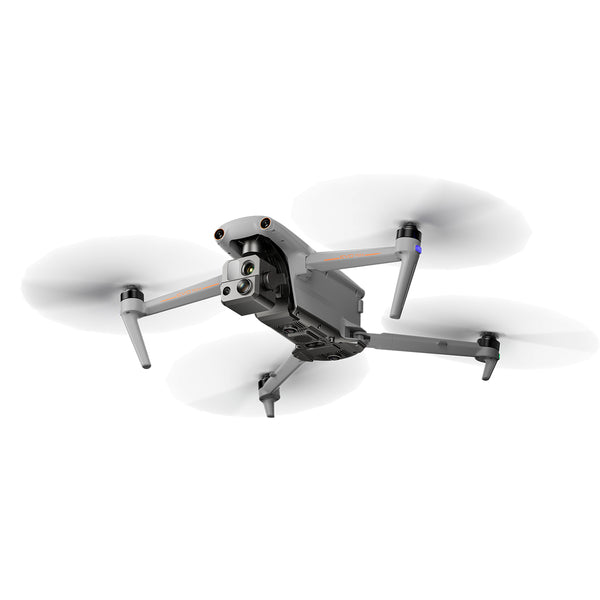The AI autonomous system of drones enhances drone situational awareness and injects new vitality into the future development of the low-altitude economy.
The AI autonomous flight mode of drones is a representative achievement of the combination of flight technology and artificial intelligence in recent years. It allows drones to automatically navigate, avoid obstacles, track or complete tasks in complex environments, greatly reducing the operating threshold.
What is drone autonomy?
Autonomous UAV drones refer to unmanned aerial vehicles that can complete flight missions autonomously without real-time human remote control. It relies on artificial intelligence, sensors and flight control systems, and has multiple capabilities such as perception, decision-making, navigation, and execution.
Compared with manually remote-controlled drones, AI autonomous drones are easier to operate, have a large range of applicable tasks, a wide range of continuous operations, and strong repeatability, without too much human intervention. Even drone novices can successfully complete drone operations.
Different levels of drone autonomy
Drone AI autonomy is good, but the cost is often more expensive. So far, there is no fully autonomous drone. We explain the different levels of drone autonomy for you.
Level 0/No Autonomy Drone: All flight functions of the drone need to be controlled by the pilot.
Level 1/Low Autonomy: Some autonomous flight capabilities exist, but the pilot remains in full control.
Level 2/Partial Autonomy: Multiple autonomous systems are in operation, but the pilot remains in full control.
Level 3/Conditional Autonomy: UAVs can fly autonomously under certain conditions. For example: the automatic follow-up shooting function of camera drones.
Level 4/High Autonomy: UAVs can fly autonomously most of the time, and the pilot only needs to interrupt the flight when necessary. For example: automatic target tracking, automatic obstacle avoidance system, route planning.
Level 5/Full Autonomy: Fully autonomous drones can operate without direct input from the pilot user. There are currently no such drones.
Main types of AI autonomous flight modes:
1. Automatic obstacle avoidance
Real-time perception of the environment through sensors such as visual cameras, ultrasonic, infrared, LiDAR, etc.
AI identifies obstacles and dynamically adjusts the flight path.
Applications: Complex environments such as forests, buildings, and indoors.
2. Target Tracking
Use computer vision and deep learning to identify people or objects.
Common technologies: Dynamic Track(Autel Robotics), ActiveTrack (DJI), Skydio Autotrack, etc.
Function: Automatically follow people/cars/boats, maintain composition, adjust height and angle.
Application: Sports shooting, Vlog, news recording, etc.
View More: Self-Flying Drone with Camera for Beginners
3. Path planning/route mission
Set multiple coordinate points, and the drone will automatically fly in sequence.
You can set speed, altitude, heading, photo instructions, etc.
Some systems support AI to automatically optimize the path according to the map/environment (such as automatically avoiding no-fly zones or telephone poles).
View More: Autonomous Drones Inspect Civil Infrastructure
4. Surround/orbit shooting
AI allows the drone to fly in a smooth circle around a target (such as a building or a person).
Automatically keep the center target centered, suitable for panoramic or close-up shooting.
5. Autonomous return
Not only can it return along the original route, but it can also avoid new obstacles.
AI determines the best return path to avoid collision or loss of control.
6. Visual Positioning / Indoor Flight
Use cameras + inertial sensors to estimate position in areas where GPS is unavailable (such as indoors).
AI calculates attitude and motion trajectory, stabilizes flight and avoids obstacles.
7. Behavior Recognition and Interaction
AI can understand human gestures, movements or voices (such as waving to take off, gesturing for directions).
Some drones can visually identify the owner and respond.
Famous drones with high autonomy
Drone manufacturers continue to pursue the entry of drone technology and move towards the goal of highly autonomous AI drones. We list the highly autonomous drones EVO MAX 4T and Autel Alpha drone for you.
Autel EVO MAX 4T

Since its release, the EVO MAX 4T has amazed drone enthusiasts with its powerful features. The Autel Max series is powerful and compact, suitable for drone missions in a variety of industries.
EVO MAX 4T supports 8K 10X zoom, multi-sensor camera, combines zoom camera, wide-angle camera, thermal imaging camera, laser rangefinder, supports A-Mesh networking technology, triple anti-interference performance, 720° obstacle avoidance performance, multiple mission planning functions, and a maximum flight time of 42 minutes.

Autel Robotics EVO MAX 4T Rugged Bundle
$8999.00 USD
Autel Alpha

Autel Alpha is an excellent industrial drone, and the drone payload and performance are even more powerful!
The Autel Alpha L-35T camera supports 35x 4K zoom camera, long and short focus thermal imaging camera, wide-angle camera, laser rangefinder, and is one of the most unique drones on the market.
Autel Alpha also supports A-Mesh networking technology, triple anti-interference performance, 720° obstacle avoidance performance, and multiple mission planning functions, and is at the forefront of autonomous UAV drones.
Final thoughts
The introduction of AI technology has taken a big step forward in the realization of autonomous flight of UAV drones. Enjoy the convenience of autonomous flight of unmanned aircraft, and look forward to the day when UAV drone AI autonomous flight is truly realized.








